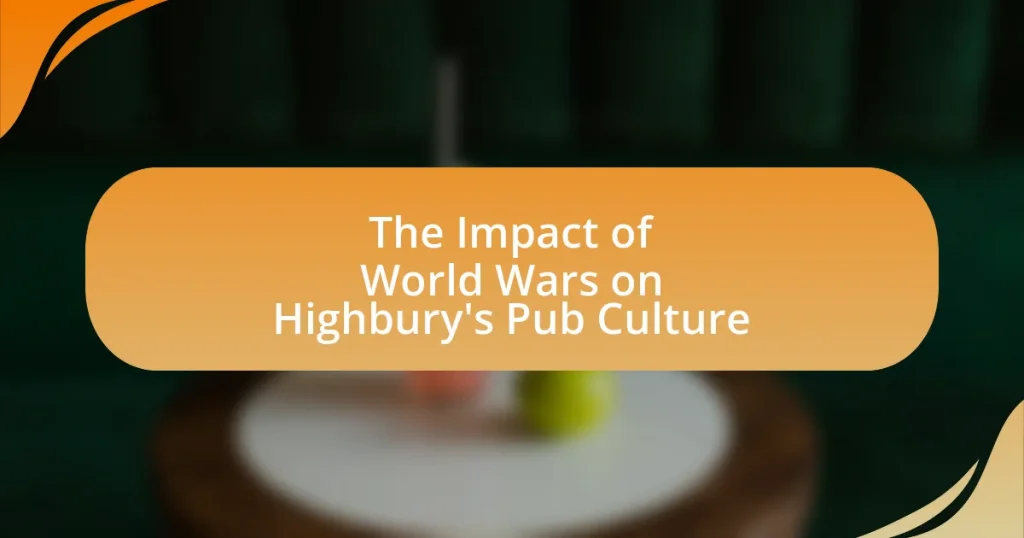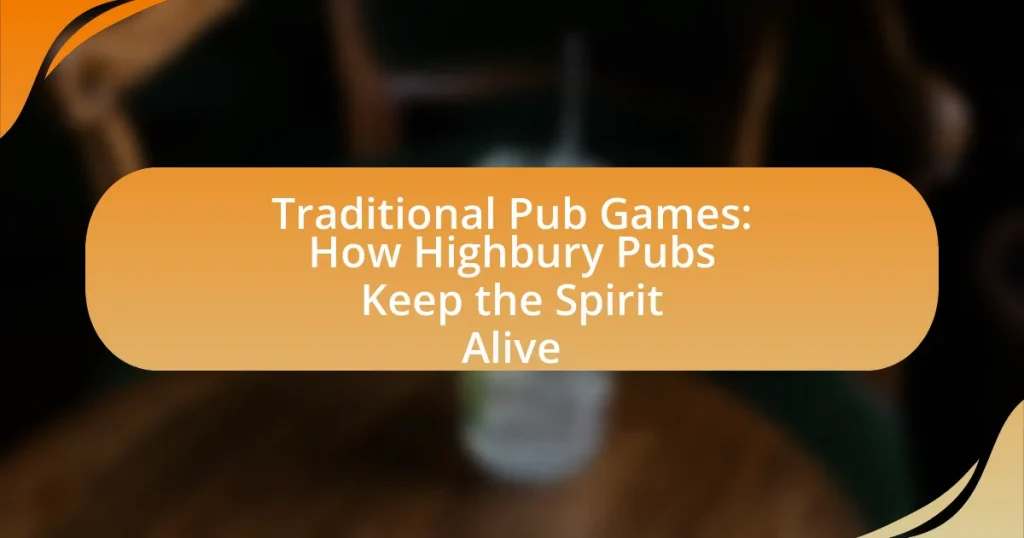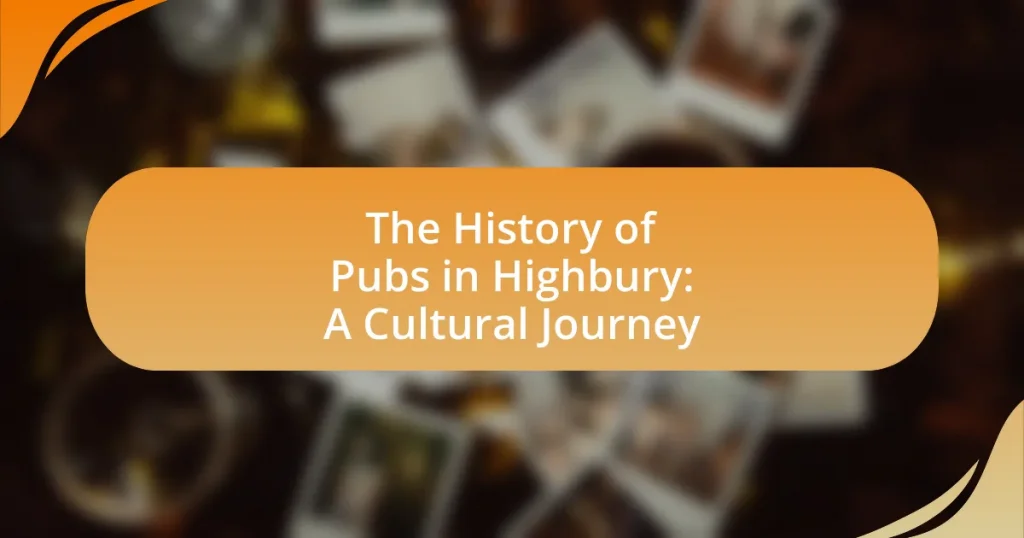The article examines the significant impact of the World Wars on the pub culture in Highbury, highlighting how these conflicts transformed pubs into essential community hubs. It details the decline in pub attendance during World War I due to rationing and economic hardship, and how World War II led to changes in operations and offerings, including increased female patronage. The article also explores the evolution of pub architecture and design post-war, the emergence of new types of drinking establishments, and the lasting legacy of the wars on contemporary pub culture in Highbury, emphasizing the role of pubs in community rebuilding and social cohesion.
What is the impact of World Wars on Highbury’s pub culture?
The impact of World Wars on Highbury’s pub culture was significant, leading to changes in social dynamics and the role of pubs as community hubs. During both World Wars, many pubs served as gathering places for soldiers and civilians, fostering a sense of camaraderie and support. The First World War saw a decline in pub attendance due to rationing and economic hardship, while the Second World War led to the establishment of pubs as essential social venues, providing solace and a sense of normalcy amidst the chaos. Post-war periods also saw a transformation in pub architecture and offerings, reflecting changing societal norms and the need for spaces that accommodated returning veterans and their families. These historical shifts illustrate how the World Wars reshaped the cultural landscape of pubs in Highbury, making them integral to community life.
How did World War I influence pub culture in Highbury?
World War I significantly influenced pub culture in Highbury by transforming these establishments into vital social hubs for community support and camaraderie. During the war, pubs became gathering places for locals to share news, support each other, and remember those who served, reflecting a shift from mere drinking venues to centers of social interaction and emotional support. The war also led to changes in the types of beverages served, with a rise in the popularity of lighter ales and stouts, as breweries adapted to wartime restrictions on ingredients. This adaptation was evident in Highbury, where local pubs began to host events and fundraisers to support soldiers and their families, further embedding the pub as a cornerstone of community life during and after the conflict.
What changes occurred in pub attendance during World War I?
During World War I, pub attendance significantly declined due to the conscription of men into the military and the overall impact of wartime restrictions. The war effort led to a shortage of labor, which reduced the number of patrons available to frequent pubs. Additionally, the introduction of rationing and restrictions on alcohol sales further diminished attendance, as many pubs faced limitations on operating hours and the types of beverages they could serve. Historical records indicate that the number of licensed premises decreased by approximately 30% during the war, reflecting the drastic changes in social habits and the pressures of wartime life.
How did the role of pubs evolve during World War I?
During World War I, the role of pubs evolved from being primarily social gathering places to becoming vital centers for community support and morale. As many men enlisted and left for the front lines, pubs served as venues for fundraising events, where communities organized efforts to support soldiers and their families. Additionally, pubs became spaces for disseminating news about the war, providing updates on local soldiers, and fostering a sense of unity among those remaining at home. The introduction of government regulations, such as restricted opening hours and the promotion of temperance, also transformed the pub environment, emphasizing their role as places for sober reflection and community solidarity rather than mere drinking establishments.
What effects did World War II have on Highbury’s pubs?
World War II significantly impacted Highbury’s pubs by leading to a decline in patronage and changes in operations. During the war, many pubs faced shortages of staff due to conscription, which reduced their ability to serve customers. Additionally, rationing of food and alcohol limited the offerings available, affecting the overall pub experience. Historical records indicate that many establishments struggled to remain profitable, with some closing permanently due to these challenges. The war also prompted changes in pub ownership and management, as some owners were unable to return after serving in the military.
How did rationing impact the offerings in Highbury’s pubs during World War II?
Rationing significantly reduced the variety and quantity of offerings in Highbury’s pubs during World War II. Due to government-imposed restrictions on food and drink supplies, pubs faced shortages of key ingredients, leading to limited beer options and a scarcity of traditional pub meals. For instance, the availability of meat, dairy, and certain grains was heavily restricted, which forced many establishments to alter their menus and rely on substitutes or simpler dishes. This situation was compounded by the overall decline in consumer goods, as pubs struggled to maintain their usual service levels while adhering to rationing guidelines.
What social changes were reflected in pub culture during World War II?
During World War II, pub culture reflected significant social changes, including increased female patronage and a shift towards communal solidarity. As men were conscripted into the military, women began to frequent pubs more frequently, taking on roles traditionally held by men, which altered the demographic landscape of these establishments. This shift was evidenced by the introduction of women-only spaces in some pubs and the rise of female bartenders, highlighting a transformation in gender roles. Additionally, pubs became centers for community support and morale, serving as venues for fundraising events and gatherings that fostered a sense of unity among locals facing the hardships of war. This communal aspect was crucial, as pubs provided a space for sharing news and experiences, reinforcing social bonds during a time of uncertainty.
How did the aftermath of the World Wars shape Highbury’s pub culture?
The aftermath of the World Wars significantly transformed Highbury’s pub culture by fostering a sense of community and resilience among locals. Following World War I and World War II, many pubs became vital social hubs where returning soldiers and residents gathered to share experiences and rebuild their lives. The destruction and loss experienced during the wars led to a shift in pub design and atmosphere, with many establishments adopting a more welcoming and inclusive environment to accommodate the needs of a diverse clientele. Additionally, the introduction of new licensing laws and the rise of working-class leisure culture contributed to the proliferation of pubs in Highbury, making them central to social life. This evolution reflected broader societal changes, as pubs became places not only for drinking but also for community engagement and support, solidifying their role in Highbury’s cultural landscape.
What lasting changes in pub architecture and design emerged post-war?
Post-war pub architecture and design saw significant changes, primarily characterized by a shift towards modernism and functionality. The destruction caused by World War II led to the rebuilding of many pubs, which incorporated open-plan layouts to create more communal spaces, reflecting a societal move towards inclusivity. Additionally, the use of new materials such as concrete and glass became prevalent, allowing for larger windows and brighter interiors, which contrasted with the darker, more traditional designs of the pre-war era. This transformation was influenced by the need for efficiency and adaptability in the post-war economy, as well as a desire to attract a broader clientele, including families. The introduction of features like outdoor seating areas and improved accessibility also became standard, marking a departure from the more exclusive, male-dominated environments of earlier pubs.
How did the interior layouts of pubs change after the World Wars?
The interior layouts of pubs changed significantly after the World Wars, shifting from traditional, compartmentalized designs to more open and communal spaces. This transformation was influenced by a desire for social interaction and inclusivity, reflecting the changing social dynamics of post-war society. For instance, many pubs eliminated small, separate rooms in favor of larger, open-plan areas that encouraged mingling among patrons. Additionally, the introduction of modern furnishings and decor aimed to create a more welcoming atmosphere, aligning with the broader cultural shifts towards relaxation and community engagement in the aftermath of the wars.
What new types of pubs or drinking establishments were established after the wars?
After the wars, particularly following World War II, new types of pubs and drinking establishments such as cocktail bars, themed pubs, and microbreweries emerged. The shift in social dynamics and consumer preferences led to the rise of cocktail bars that catered to a more sophisticated clientele, reflecting a cultural change towards leisure and entertainment. Themed pubs, often designed around specific concepts or historical periods, became popular as they offered unique experiences that differentiated them from traditional establishments. Additionally, the craft beer movement spurred the establishment of microbreweries, which focused on small-scale production and local ingredients, appealing to a growing interest in artisanal and locally sourced products. These developments marked a significant evolution in pub culture, influenced by the societal changes that occurred during and after the wars.
How did the community’s relationship with pubs evolve after the World Wars?
After the World Wars, the community’s relationship with pubs shifted from viewing them primarily as places for socializing and leisure to recognizing them as vital community hubs for support and connection. This evolution was influenced by the collective trauma and loss experienced during the wars, which led to a greater emphasis on community solidarity. Pubs became venues for commemorating fallen soldiers and fostering a sense of belonging among locals, as evidenced by the establishment of memorials and events held in their honor. Additionally, the post-war economic recovery and changes in social norms contributed to a resurgence in pub culture, making them central to community life in Highbury.
What role did pubs play in community rebuilding after the wars?
Pubs served as vital social hubs in community rebuilding after the wars, facilitating social interaction and fostering a sense of belonging among residents. Following World War I and World War II, many communities faced significant social fragmentation due to loss and displacement. Pubs provided a space for individuals to gather, share experiences, and rebuild social networks. Historical evidence shows that in the aftermath of these conflicts, local pubs often hosted community events and meetings, which helped to re-establish connections and promote collective healing. For instance, in the UK, the establishment of the “pub as a community center” model became prominent, where pubs organized activities that encouraged community engagement and support, thus playing a crucial role in the recovery process.
How did the demographics of pub-goers change in the post-war era?
In the post-war era, the demographics of pub-goers shifted significantly, with an increase in female patrons and a more diverse age range. Following World War II, societal changes, including the rise of women’s participation in the workforce and changing social norms, led to women increasingly frequenting pubs, which had traditionally been male-dominated spaces. Additionally, the introduction of licensing reforms and the expansion of pub hours attracted a broader demographic, including younger adults and families. This transformation was evidenced by the 1960s and 1970s, when pubs began to cater to a wider audience, reflecting the changing social landscape of Britain during that time.
What are the contemporary implications of the World Wars on Highbury’s pub culture?
The contemporary implications of the World Wars on Highbury’s pub culture include a shift in social dynamics and the preservation of communal spaces. The World Wars significantly influenced the development of pubs as vital social hubs, fostering a sense of community among locals, particularly during and after wartime. Historical data indicates that many pubs became gathering places for returning soldiers and their families, reinforcing their role in local culture. Additionally, the architectural styles and themes in many Highbury pubs reflect wartime influences, with some establishments commemorating local history and sacrifices made during the conflicts. This legacy continues to shape the atmosphere and identity of Highbury’s pubs today, making them not only places for socializing but also sites of historical significance.
How do modern pubs in Highbury reflect their historical roots from the World Wars?
Modern pubs in Highbury reflect their historical roots from the World Wars through their architecture, themes, and community focus. Many pubs retain original features such as wooden beams and stained glass, reminiscent of the era when they served as gathering places for soldiers and locals during the wars. Additionally, some establishments incorporate wartime memorabilia and host events that commemorate local history, fostering a sense of community and remembrance. This connection is further emphasized by the pubs’ roles as social hubs, echoing their historical function as places for camaraderie and support during challenging times.
What traditions from the World Wars are still observed in Highbury’s pubs today?
Highbury’s pubs today still observe traditions such as commemorative events and the display of war memorabilia. These practices honor the sacrifices made during the World Wars, with pubs often hosting Remembrance Day services and displaying poppies, which symbolize remembrance. Additionally, some pubs maintain a tradition of serving specific dishes or drinks that were popular during wartime, reflecting the historical context of the era. This connection to the past reinforces community ties and collective memory, ensuring that the impact of the World Wars remains a significant part of Highbury’s pub culture.
How do current pub owners honor the legacy of World War-era establishments?
Current pub owners honor the legacy of World War-era establishments by preserving historical architecture and memorabilia that reflect the period. Many pubs maintain original features such as wooden beams, stained glass, and wartime artifacts, creating an authentic atmosphere that connects patrons to the past. Additionally, some establishments host themed events or serve traditional dishes and drinks that were popular during the war years, fostering a sense of nostalgia. This practice not only pays tribute to the resilience of communities during the wars but also attracts customers interested in the rich history of their local pubs.
What lessons can be learned from the impact of the World Wars on Highbury’s pub culture?
The impact of the World Wars on Highbury’s pub culture teaches that social spaces adapt to societal changes and community needs during crises. During World War I and World War II, pubs in Highbury became vital gathering places for locals, fostering a sense of community and resilience amidst adversity. Historical records indicate that these establishments often served as venues for fundraising efforts and support for troops, reflecting their role in uniting the community. Additionally, the post-war period saw a transformation in pub culture, with an increase in the diversity of clientele and the introduction of new social norms, highlighting how wartime experiences can reshape cultural practices.
How can modern pubs adapt to changing social dynamics while respecting history?
Modern pubs can adapt to changing social dynamics while respecting history by integrating contemporary social spaces with traditional pub elements. This can be achieved by maintaining historical architecture and decor while offering diverse menus and inclusive events that cater to a broader audience. For instance, many pubs have successfully incorporated community-driven initiatives, such as hosting local art exhibitions or live music nights, which honor the cultural significance of pubs as community hubs established during the World Wars. Historical records indicate that pubs served as vital social gathering places during wartime, fostering community resilience; thus, modern adaptations that celebrate this legacy can enhance relevance while preserving the essence of pub culture.
What best practices can be derived from the historical evolution of Highbury’s pubs?
Best practices derived from the historical evolution of Highbury’s pubs include community engagement, adaptability to social changes, and preservation of local heritage. Highbury’s pubs historically served as community hubs, fostering social connections and local identity, which emphasizes the importance of creating spaces that encourage community interaction. Additionally, the ability of these establishments to adapt to societal shifts, such as changes in demographics and consumer preferences, showcases the necessity for flexibility in business models. Furthermore, the preservation of local heritage through the maintenance of traditional pub architecture and practices reinforces the value of cultural continuity, as seen in Highbury’s pubs that have retained their historical significance despite modern challenges.



